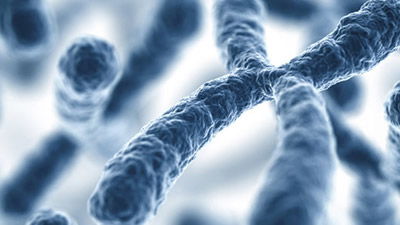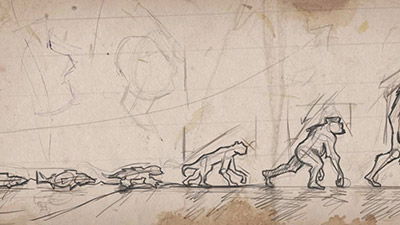
Homo erectus Grew Teeth Like Modern Humans, Not Like Chimps
Teeth of Homo erectus grew like modern human teeth but not like chimps.
News Source
- NewScientist: “Your Molar Roots Are Leftovers from Homo erectus”
A dentist once told me that I didn’t need to floss all my teeth—only the ones I wanted to keep! Teeth show wear from abrasion and accumulation of dental calculus on the outside, particularly without the benefit of modern dental hygiene. But the inside of our teeth also tells a story. Our permanent teeth, because they are designed to last a lifetime, preserve a record of their growth in their microscopic structure. A study comparing the teeth of modern humans, chimpanzees, and hominid fossils has found results that surprised evolutionary researchers. In a nutshell, they discovered that the teeth of Homo erectus had a growth pattern matching that of modern humans and not chimpanzees.
 The tooth diagram on the left shows the tooth root (at the top) and the exposed crown of the tooth covered with enamel (E). Lines in the enamel (E) and the dentine (D) indicate the microscopic markers, analogous to tree rings, that show the regular pattern of tooth growth. Microscopic examination of a tooth root (top right, with the dentine adjacent to the cementum that helps hold the tooth in place) and crown (bottom right) can be used to measure how fast the tooth parts grow and to determine whether one part has been growing longer than another. Image credit: www.plosone.org
The tooth diagram on the left shows the tooth root (at the top) and the exposed crown of the tooth covered with enamel (E). Lines in the enamel (E) and the dentine (D) indicate the microscopic markers, analogous to tree rings, that show the regular pattern of tooth growth. Microscopic examination of a tooth root (top right, with the dentine adjacent to the cementum that helps hold the tooth in place) and crown (bottom right) can be used to measure how fast the tooth parts grow and to determine whether one part has been growing longer than another. Image credit: www.plosone.org
“Our roots are stuck in the past,” commented study coauthor M. Christopher Dean, indicating his belief that molar roots had failed to keep up with human evolution.
In order for teeth not to rip out of the jaw once chewing begins, they need sturdy roots.
In order for teeth not to rip out of the jaw once chewing begins, they need sturdy roots. The study’s authors noted that the hardest bit of data to uncover was the age at which chimpanzee teeth begin to peek through the gums—presumably owing to the general unwillingness of young chimpanzees to open wide for a gum inspection. Ultimately they did succeed in comparing the age at which chimp and modern human teeth erupt to the age at which the tooth roots begin to grow rapidly. If chimps are somewhat uncooperative, it can be safely said that hominid fossils are unforgivably reticent about the age at which their teeth erupt, as fossils can’t be observed teething in real time and don’t have gums. Once their teeth erupted, though, the original owners likely began to use them to chew, so eruption was gauged by the presence of abrasion.1
Dean and Tim Cole compared the age of the tooth crowns to the age of the roots indirectly. They examined the teeth of modern humans, chimpanzees, and four “hominids” by looking at the microscopic structure. Tooth growth follows a circadian rhythm. Tooth enamel covering the crown and the dentine core of a tooth’s root both contain telltale microscopic markings produced by daily fluctuations in growth.They first determined in modern specimens the growth rate represented by these markings. Then, by comparing the markings in crowns and roots, they were able to calculate whether or not each tooth root had a significant head start.2
Chimpanzee molars, it turns out, simultaneously erupt through the gums and get a root growth spurt. Modern humans, however, begin growing a sturdy root for their molars long before the teeth erupt. Four “hominid” molars, felt by Cole and Dean to represent the course of human evolution from ape-like ancestors, included three apes (one being an australopithecine) and one Homo erectus. The researchers were surprised to find the molar from the Homo erectus showed a growth pattern comparable to modern humans, with the root having gotten a head start in growth before the tooth erupted.3
Homo erectus had smaller teeth than apes. (So do modern humans.) And humans have a longer childhood than apes. The researchers propose that smaller teeth in Homo erectus represented an evolutionary change from ape-like ancestors reflecting a human’s longer childhood and diet of more cooked foods. They indicate that selection pressure caused the teeth to erupt later in a human than an ape because the childhood is longer. But they consider the fact that molar roots begin growing much earlier than human teeth to be an “evolutionary leftover,” saying that tooth roots don’t cost the body much energy and so failed to evolve a delay in development as hominids became more human.4
This research provides a good example of how objective data can be given an evolutionary spin in order to try to make it support the evolutionary story. The researchers offer no experimental support for the evolutionary interpretation because there is none.
A much more straightforward—not to mention biblically correct—way to view the data is to note that humans and chimps develop differently because they do not share an evolutionary ancestor. Homo erectus’s molar grew like a modern person’s molar because both are human. God’s design for human development includes longer childhood than apes, smaller teeth than apes, and molar roots that begin growing long before the teeth erupt. God created apes and humans on the same day about 6,000 years ago without using evolutionary predecessors.
Further Reading
- Brainfood: Cooking (catching fire)
- Did Humans Really Evolve from Apelike Creatures?
- History Channel Survey of Human History (mankind’s story)
- Cooking: The World’s Oldest Profession (culinary secrets of evolutionary success)
- Promethean Hypothesis from Cooking Fire (Promethean secrets)
- Vegetables for Neanderthals (Neander-eats)
- Dispute Over Largest Group of Human Fossils (who’s who of human fossils)
- Ancient Humans Grazing? (ancestral grazing)
- Enigmatic Skull Confirmed to Have Flat Face (who’s who among Homo)
- Neanderthals vs. Humans: Are They Different?
- When Did Cavemen Live?
- Were Cavemen Real?
- “The Search for the Historical Adam” and Population Genomics
- Are Wisdom Teeth (Third Molars) Vestiges of Human Evolution?
- Audio: Answers Daily: Ancient Toothpaste
- Are Wisdom Teeth (Third Molars) Vestiges of Human Evolution?
- Is Lack of Room for Wisdom Teeth Proof of Evolution?
For More Information: Get Answers
Remember, if you see a news story that might merit some attention, let us know about it! (Note: if the story originates from the Associated Press, FOX News, MSNBC, the New York Times, or another major national media outlet, we will most likely have already heard about it.) And thanks to all of our readers who have submitted great news tips to us. If you didn’t catch all the latest News to Know, why not take a look to see what you’ve missed?
(Please note that links will take you directly to the source. Answers in Genesis is not responsible for content on the websites to which we refer. For more information, please see our Privacy Policy.)
Footnotes
- Information in this paragraph is drawn directly from M. Christopher Dean and Tim J. Cole, “Human Life History Evolution Explains Dissociation between the Timing of Tooth Eruption and Peak Rates of Root Growth,” PLoS One 8, no. 1 (January 14, 2013): doi:10.1371/journal.pone.0054534.
- Ibid.
- Ibid.
- Ibid.

Answers in Genesis is an apologetics ministry, dedicated to helping Christians defend their faith and proclaim the good news of Jesus Christ.
- Customer Service 800.778.3390
- Available Monday–Friday | 9 AM–5 PM ET
- © 2025 Answers in Genesis



